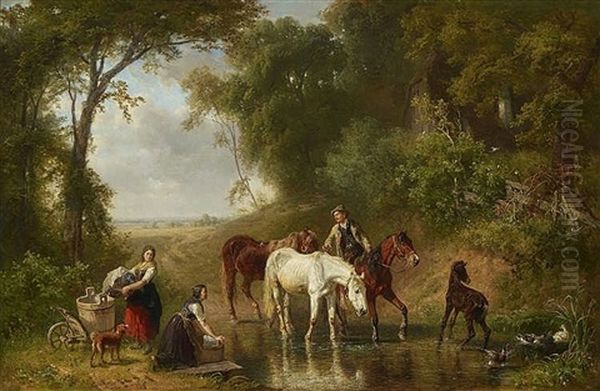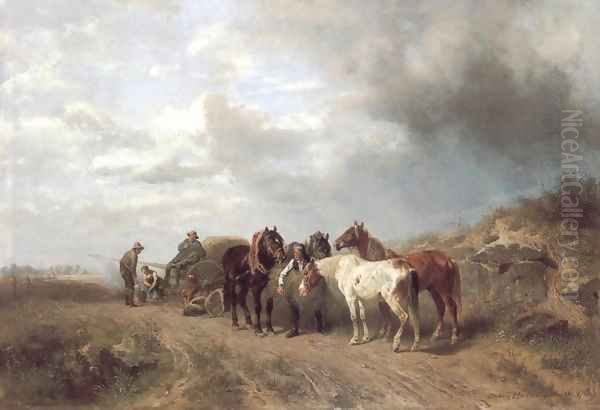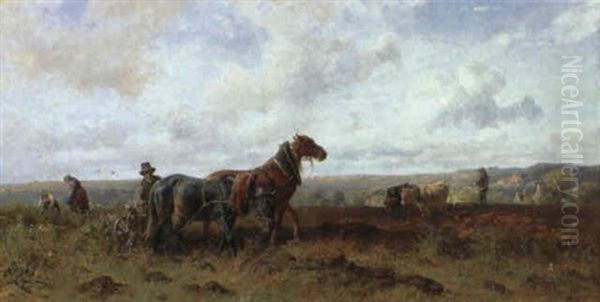Ludwig Hartmann stands as a significant figure in 19th-century German art, particularly associated with the Munich School. Born in Munich in 1835 and passing away there in 1902, his artistic career was dedicated to capturing the essence of rural Bavaria, with a special focus on animals, pastoral figures, and the landscapes of the highlands. His work provides a valuable window into the agricultural life and natural beauty of the region during his time.
Early Life and Artistic Beginnings
Hartmann's journey into the art world began in his native Munich. In 1854, he undertook training in printmaking, a discipline that often hones an artist's sense for line and composition. Although his time formally studying printmaking was relatively brief, it likely provided a foundational understanding of visual structure. He also spent a short period studying under the artist Johann Wagner-Deines, which would have further shaped his early artistic direction and technical skills, possibly influencing his approach to depicting figures and scenes from daily life.
Entering the Munich Art World
Munich in the mid-to-late 19th century was a vibrant hub for artists, rivaling Paris and Vienna in importance within the German-speaking world. Hartmann successfully navigated this competitive environment. A key connection was Eduard Schleich the Elder (d.Ä.), a prominent landscape painter himself. Through Schleich's introduction, Hartmann gained access to important circles within the Munich art scene. This network would have been crucial for exposure, patronage, and artistic exchange, allowing him to establish his presence among contemporaries.
Collaboration and Development
A significant step in Hartmann's professional life was the establishment of a shared studio. From 1870 onwards, he collaborated with fellow artist Otto Gebler, known for his animal paintings, particularly sheep. They set up their joint workspace in Pahl, a location likely chosen for its proximity to the rural subjects they favoured. Working alongside Gebler would have provided opportunities for mutual influence, critique, and the sharing of techniques, contributing significantly to Hartmann's artistic development during this period.
Artistic Style: Realism and Atmosphere

Ludwig Hartmann's painting style is firmly rooted in the realist traditions prevalent in Munich during his era. His work is characterized by a keen observation of nature and rural life. A notable influence on his painterly technique was Eduard Seitz, whose impact can be seen in Hartmann's confident brushwork and handling of form. Hartmann excelled in creating compositions that were both well-structured and atmospherically convincing. He paid close attention to the effects of light and shadow, using them to model forms and evoke the specific mood of a scene, whether it be the bright light of a summer field or the softer tones of dusk. His palette was often rich and vibrant, reflecting the colours of the Bavarian landscape and the textures of animal hides and rustic clothing.
Core Themes: The Bavarian Highlands
The heart of Hartmann's oeuvre lies in his depiction of the Bavarian highlands and its inhabitants. He repeatedly returned to subjects drawn directly from this environment. Horses, particularly workhorses, were a favourite and recurring motif, portrayed with anatomical accuracy and a sense of their vital role in rural labour. Draught oxen, powerful and patient, also feature prominently, often shown pulling ploughs or carts. Shepherds tending their flocks are another common theme, capturing a timeless aspect of pastoral life. Furthermore, Hartmann documented the various modes of transport used in the region, such as horse-drawn wagons and carts, embedding these elements within detailed landscape settings. His dedication to these themes makes his work an important visual record of Bavarian culture in the 19th century.
Mastery of Animal Painting
Hartmann's reputation was significantly built on his exceptional skill as an animal painter. He possessed a deep understanding of animal anatomy and behaviour, particularly concerning horses and cattle. His depictions go beyond mere representation; they convey the weight, movement, and individual character of the animals. Whether showing horses straining at a plough, resting by a pond, or gathered around a campfire, he captured their presence with remarkable fidelity. This focus placed him among other notable Munich animal painters, such as Benno Adam, known for his dogs and hunting scenes, and Friedrich Voltz, who also specialized in cattle and Alpine landscapes. Hartmann's ability to integrate these animals seamlessly into broader landscape and genre scenes was a hallmark of his talent.
Representative Works: Capturing Rural Moments
Several specific works exemplify Hartmann's style and thematic concerns. Bauer mit Pferden am Waldteich (Farmer with Horses by the Forest Pond), an oil painting dated 1865, is considered a high-quality early work. It garnered significant praise from contemporary artists and critics upon its creation and achieved a notable price (€62,500) at auction in 2015, attesting to its enduring appeal. Another representative piece is Auf dem Feld (On the Field), a smaller oil painting (27 x 44.5 cm) that encapsulates his focus on agricultural scenes.

Other documented works further illustrate his range, including Treidler mit ihren Pferden bei einem Lagerfeuer (Towpath Haulers with their Horses by a Campfire) from 1896, showcasing a scene of rest after labour, and Schimmel auf dem Weide (White Horse in the Pasture), an oil painting from 1876. Works like Pferdehirt von Markt heimkehrend (Horse Herdsman Returning from Market) and Bauern beim Pflügen (Farmers Ploughing), potentially linked to his time studying under Wagner-Deines, also highlight his commitment to depicting everyday rural activities with authenticity. A scene described as featuring a herdsman and two maids by a forest lake was also noted for its high quality.
Contemporary Recognition and Connections
During his lifetime, Ludwig Hartmann achieved considerable recognition within the Munich art community. His early works, particularly those from the 1860s, were highly praised. A critic for the Leipziger Zeitung, reviewing Munich exhibitions, lauded his paintings. Importantly, his talent was acknowledged by respected fellow artists. Among those cited as admiring his work were the aforementioned Benno Adam and Friedrich Voltz, as well as the Swiss animal painter Rudolf Koller and the landscape painter Anton Steffan. This peer recognition underscores his standing in a competitive field. His professional relationships with Eduard Schleich d.Ä., Otto Gebler, and Eduard Seitz further situate him within the network of influential Munich artists, which also included figures like the landscape painter Adolf Lier and prominent realists such as Wilhelm Leibl, though Leibl's focus was more on portraiture and figure studies. The broader Munich scene also included famous portraitists like Franz von Lenbach and later figures like Albert von Keller and Hugo von Habermann.
A Touch of Controversy?
While primarily known for his pastoral scenes, an anecdote suggests Hartmann occasionally explored themes that might have been considered risqué for the time. A design for a pipe, reportedly featuring a depiction of a nude woman alongside a flowerpot, was described as a potentially daring creation within the context of Victorian-era sensibilities. It was speculated that such an item might have been intended strictly for private use, perhaps within a gentleman's study or smoking room. While a minor footnote in his career, this suggests an artist occasionally willing to engage with subjects beyond the purely conventional, albeit perhaps only in more private or specialized contexts.
Legacy and Market Presence

Ludwig Hartmann's primary legacy lies in his contribution to the genre of Bavarian landscape and animal painting. He meticulously documented a way of life that was intrinsically linked to the land and its animals. His works offer a realistic, yet often idyllic, portrayal of the Bavarian highlands in the latter half of the 19th century. While perhaps not as revolutionary as some of his contemporaries, his technical skill and consistent focus earned him a solid reputation. The continued appearance of his paintings at auctions, sometimes fetching significant prices, indicates an ongoing appreciation for his work among collectors. Although the provided sources do not specify collections in major public museums, his paintings likely reside in various regional German museums and private collections, preserving his vision of Bavarian rural life for future generations.
Conclusion: Hartmann's Place in German Art
Ludwig Hartmann carved out a distinct niche within the bustling Munich art scene of the 19th century. As a skilled painter of animals and landscapes, he dedicated his career to capturing the specific character of the Bavarian highlands and the lives of its people and working animals. Influenced by contemporaries like Eduard Seitz and collaborating with artists like Otto Gebler, he developed a style marked by realism, careful composition, and atmospheric sensitivity. Praised by fellow artists such as Benno Adam and Friedrich Voltz, he was a respected member of the Munich School. His enduring legacy is that of a chronicler of Bavarian rural life, whose works continue to be valued for their artistic merit and historical insight.